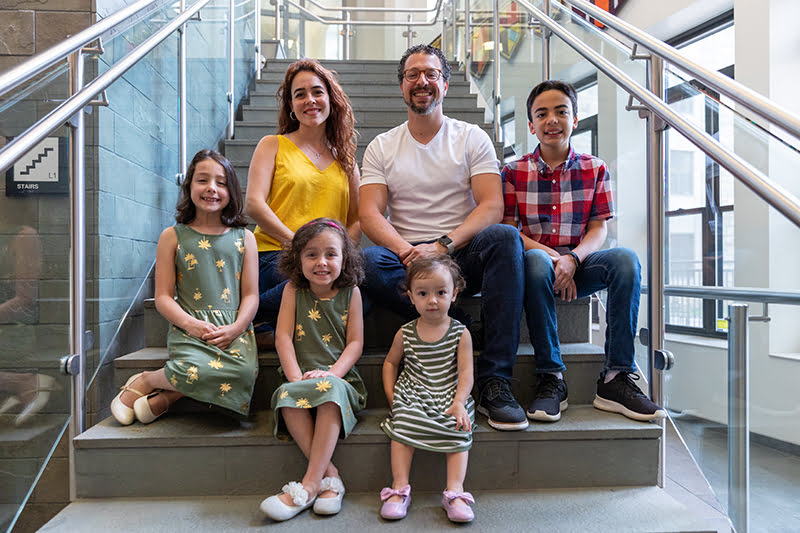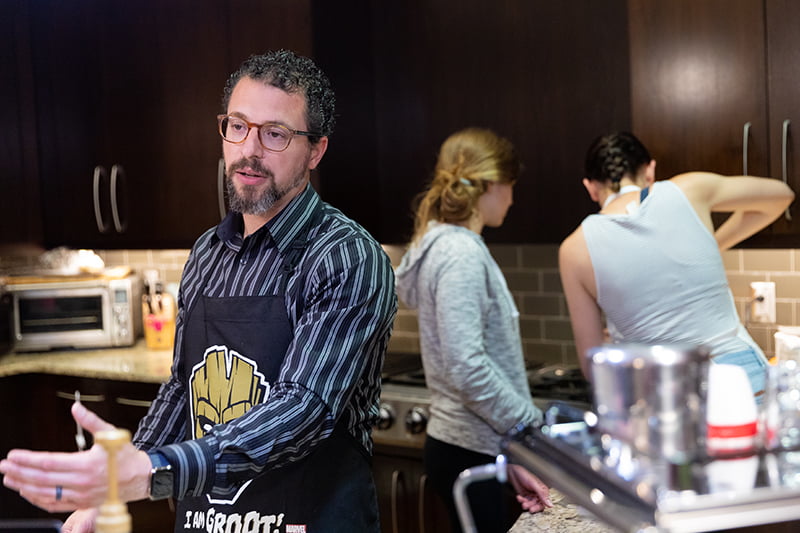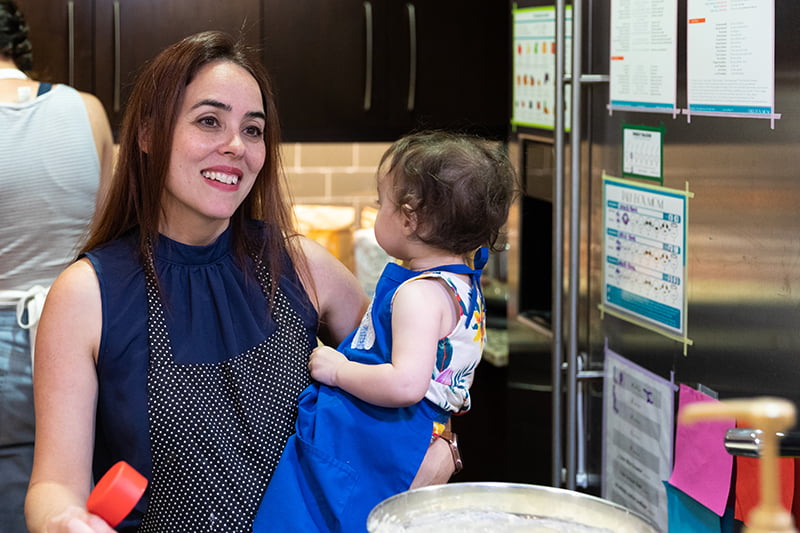
by Marya Barlow
Two years ago, Pablo Tarazaga and his family of six left their house in Blacksburg’s Woodbine neighborhood to join 325 honors students in a residential hall on Virginia Tech’s main campus.
Tarazaga, wife Vanessa ’05, a son, three daughters, and a collie moved into a sunny, furnished faculty condo on the fourth floor of East Ambler Johnston Hall. The prolific researcher, associate professor of mechanical engineering, and Virginia Tech alumnus M.S. ’04, Ph.D. ’09, hoped to use his new role as faculty principal in the Honors Residential Commons (HRC) to forge connections with students beyond the classroom.
“I never thought of the university as just a place for vocation and study,” said Tarazaga, a John R. Jones III faculty fellow. “It’s about the formation of the student as a whole, as a thinking person. My wife and I were really drawn to being part of these students’ lives and helping them walk through this challenging, formative time.”
Practically overnight, the Tarazaga clan morphed from a band of six into a tight-knit family of hundreds. Students came by the dozens to join the Tarazagas for Tuesday dinners in the D2 dining hall, Friday Principal’s Teas, and Saturday ice cream socials. HRC residents and the Tarazaga children worked on homework assignments side-by-side. Spontaneous games of tag, hide-and-seek, kickball, and soccer with the kids became stress-relieving diversions for the college students. Tarazaga family movie nights swelled to 40-person affairs.
And the interactions continued to grow—in quantity, in attendance, and in creativity.

Over Tuesday night Spanish Coffees, students and faculty practice Spanish conversation skills. Tarazaga family holidays expanded to include students who remained on campus during breaks. Using a secure messaging platform, the family created a group called “Tarazaga Family Happenings” to invite residents to participate in daily activities like walks with the dog, outdoor games, visits to the farmer’ market, or crafts in the apartment. In an elementary school parking lot before one of the children’s soccer games, the students even staged a surprise tailgate party—complete with a grill, music, and a large Hokie cheering section.
And one night before final exams, 50 students lined up inside the Tarazagas’ apartment where the family served Breakfast for Dinner—pancakes, waffles, and mini-quiches—assembly-line style.
“They’re like parents away from home,” said Devon Barbour, a junior physics major who is spending her third year in the HRC because of the Tarazagas. “They welcome us into their home. They’ve made us such an intimate part of their lives. They give so much to this community and don’t ask for anything in return.”
“It’s been a blessing,” said Vanessa. “The students really embraced our family. Our kids love it. They say they never want to leave.”
“We didn’t realize the extent to which those great relationships would develop,” added Pablo. “We do life together. It’s walking with the students in the formation of who they are. For me, this is a very fulfilling way of being a professor.”
From “crazy” to coveted
When Frank Shushok introduced the residential college model at Virginia Tech in 2009, the reception was cautiously optimistic.
“People said the idea that faculty might want to live with our students was crazy,” said Shushok, senior associate vice president for student affairs and associate professor of higher education. “What we’re finding is it’s having as profound of an impact on faculty as it does on students. Many of our faculty are saying it’s the single most powerful and influential experience in strengthening the way they teach and their empathy and understanding of students. They love being invested in students’ lives in a longitudinal way.”
Shushok says living-learning programs not only blend academic and student life, but also enrich the university’s close-knit culture. “Residential environments on college campuses are often very underutilized resources,” he said. “When we move from sleep-eat environments to live-learn environments, this creates the groundwork for the kind of education that we espouse and deeply admire.”
Regarded as a pioneer in the field, Shushok successfully instituted residential colleges at Baylor University a decade before introducing them at Virginia Tech. He’s published numerous studies that affirm the benefits of living-learning environments—benefits that include improved student academic performance, co-curricular engagement, persistence toward graduation, and overall well-being—and he co-authored one of the first studies to examine the faculty benefits.
Virginia Tech remains relatively unique among peer land-grant research universities for embracing residential colleges. The Residential College Society, founded in 2014 at the university, has blossomed into a national organization of universities exchanging best practices.
A family away from home
Students living in the Honors Residential College are universally effusive when it comes to their living-learning experience with the Tarazagas.
Nathan Schlundt, a junior from Los Angeles, said moving into the Honors Residential College improved his entire outlook. “My first year was kind of lonely because I was far from home and hadn’t found my niche yet,” said Schlundt, a computer science major. “When I came to the HRC, it was a total 180. Dr. T and his family produce a great sense of community. They’re always bringing us together and inviting us into their home with events like this. Look at them—they’ll cook three hours just for us.”
Tyler Pugh, a junior double-majoring in industrial systems engineering and Spanish, said Tarazaga has become a mentor. “I really wish I had him as a professor,” said Pugh, who is also a resident advisor in the HRC. “Dr. Tarazaga is so invested in his students’ character. We get coffee every Saturday and talk about anything and everything. Sometimes I forget he’s an award-winning researcher. I wasn’t able to go back home for New Year’s with my family, which is a tradition we usually celebrate together. The Tarazagas invited me here. Another day over winter break, I had dinner with them. They bring the home into the dorm for us.”

Pugh said having kids and a dog around has also been a highlight.
“When I’m with them, I’m not a student anymore. I’m part of the family. I forget my tests and papers. This is my time to de-stress,” he said. “When you’re able to sit down and just color with them, it takes your mind off of being a student. You can enjoy just being a friend with these kids.”
Enriching faculty families
After moving into Ambler Johnston, the Tarazagas noticed the positive impact on their children right away.
“It’s an immersive living-learning environment for them, too,” said Vanessa, who homeschools all four children. “The campus is a wonderful, lively place to grow up. There’s always something interesting going on that we can integrate into their schoolwork. And the students are great role models. They study with them, play with them, and welcome them into their lives.”
The faculty principal arrangement isn’t without its drawbacks—like when the fire alarm went off 22 times during the semester after the Tarazagas moved in with a new baby. Sometimes upstairs neighbors need gentle reminders to tread more softly in the common area above the couple’s master bedroom, and more often than not, a quick trip out to walk the dog can evolve into a half-hour conversation with passing students, staff, or faculty.
But the positives far outweigh the negatives, the family resoundingly agrees. Asked if he misses his neighborhood and backyard, the Tarazaga’s 11-year-old son is emphatic. “I have the biggest, best backyard right here,” he said, gesturing toward the Drillfield.
‘Pretty darn transformational’
The faculty principal position is a three-year commitment, which can be renewed just once. At the end of their first three-year term, the Tarazagas signed on again. The faculty principals in the other two residential colleges also chose to stay.
Tim Baird, associate professor of geography and senior fellow of the Institute for Creativity, Arts, and Technology, is interested in applying to become a faculty principal in the Creativity and Innovation District. His wife and three children are excited about the prospect.
“We think it would be good for our kids and strengthen our family,” he said. “For me, this is what it means to be a professor in its entirety. When you’re ensconced in academics, student life, facilities, and all the facets of the university, you can see it more clearly and be more effective in contributing.”
For Shushok, the growing interest is validation that Virginia Tech is on the right path.
“We should take heart that we have the most student-centered faculty that are also amazing, productive researchers and scholars,” he said. “That says a lot about the education you can get at Virginia Tech. In many ways, our residence halls are exemplars of transdisciplinary learning. Bringing together students, faculty, and staff of different acculturations and expertise to work together, think together, and dream together.
“At the end of the day, that’s pretty darn transformational.”


